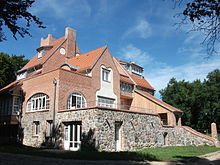Oskar Kruse
Oskar Kruse (born May 25, 1847 in Stettin , † August 10, 1919 in Kloster auf Hiddensee ), also known as Oskar Kruse-Lietzenburg , was a German painter . With the construction of the Lietzenburg and the artists' meetings that took place there, he shaped the cultural image of Hiddensee at the beginning of the 20th century.
Life
Oskar Kruse was born in 1847 as the second child of a family of merchants from Szczecin. Together with his two siblings, he grew up in a musical environment. He initially embarked on a successful commercial career. In 1890, as the owner of a large timber trade, he had a house built on Lietzenburger Strasse in Berlin- Charlottenburg, which he called Lietzenburg .
In 1889 he gave up his commercial profession to study painting in Berlin. Soon afterwards he went to Munich , where he was supported by Fritz von Uhde . In 1893 he visited the Dachau artists' colony, which was then known throughout Germany . The painters living there oriented themselves mainly towards Parisian artists, so that he went to Paris in 1894 to study at the Académie Julian .
In the same year he exhibited his works for the first time under the name Oskar Kruse-Lietzenburg . In 1899, Kruse became a member of the Berlin Secession , a group of progressive Berlin artists that had split off from the academic art scene. In 1903 and 1904 he made trips to London and Italy . Study trips in Germany took him first to Lohme on the island of Rügen , then on to the island of Hiddensee.
Hiddensee fascinated him so much that in 1904 he had an Art Nouveau villa built in the island town of Kloster , his second Lietzenburg . When he received his paternal inheritance, he began his plan to create an artists' colony on the island. He was supported by his brother Max Kruse , a sculptor who had actually planned an artists' colony on Lake Maggiore . In the summer, Oskar Kruse gathered numerous artists in the Lietzenburg, where he excelled in the evenings as a narrator of imaginative stories. The sometimes grotesque stories earned him the name Münchhausen among the audience , while the islanders called him Uncle Os .
In 1919 Oskar Kruse died in the monastery in the "Haus am Meer" estate. He was buried in the local cemetery. His brother and his wife Käthe Kruse continued to run the Lietzenburg.
Oskar Kruse-Lietzenburg was a member of the German Association of Artists .
Individual evidence
- ^ Oskar Kruse-Lietzenburg . In: Gallery "The Panther" . May 21, 2015 ( galerie-der-panther.de [accessed November 29, 2016]).
- ↑ kuenstlerbund.de: Ordinary members of the German Association of Artists since it was founded in 1903 / Kruse-Lietzenburg, Oskar ( Memento of the original from March 4, 2016 in the Internet Archive ) Info: The archive link was inserted automatically and has not yet been checked. Please check the original and archive link according to the instructions and then remove this notice. (accessed on September 30, 2015)
literature
- Ruth Negendanck : Hiddensee: the special island for artists. Edition Fischerhuder art book 2005, ISBN 978-3-88132-288-1 . Pp. 28-31, 47-50.
- Grete Grewolls: Who was who in Mecklenburg and Western Pomerania. The dictionary of persons . Hinstorff Verlag, Rostock 2011, ISBN 978-3-356-01301-6 , p. 5524 .
Web links
- Artist on Hiddensee: Oskar Kruse-Lietzenburg
- Oskar Kruse: The lord of the castle of Hiddensee
- Literature about Oskar Kruse in the state bibliography MV
- Works by Oskar Kruse on artnet
| personal data | |
|---|---|
| SURNAME | Kruse, Oskar |
| ALTERNATIVE NAMES | Kruse-Lietzenburg, Oskar (full name) |
| BRIEF DESCRIPTION | German painter, builder of the Lietzenburg on Hiddensee |
| DATE OF BIRTH | May 25, 1847 |
| PLACE OF BIRTH | Szczecin |
| DATE OF DEATH | August 10, 1919 |
| Place of death | Monastery on Hiddensee |

